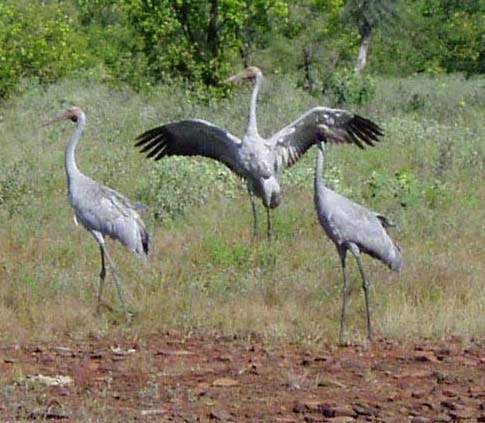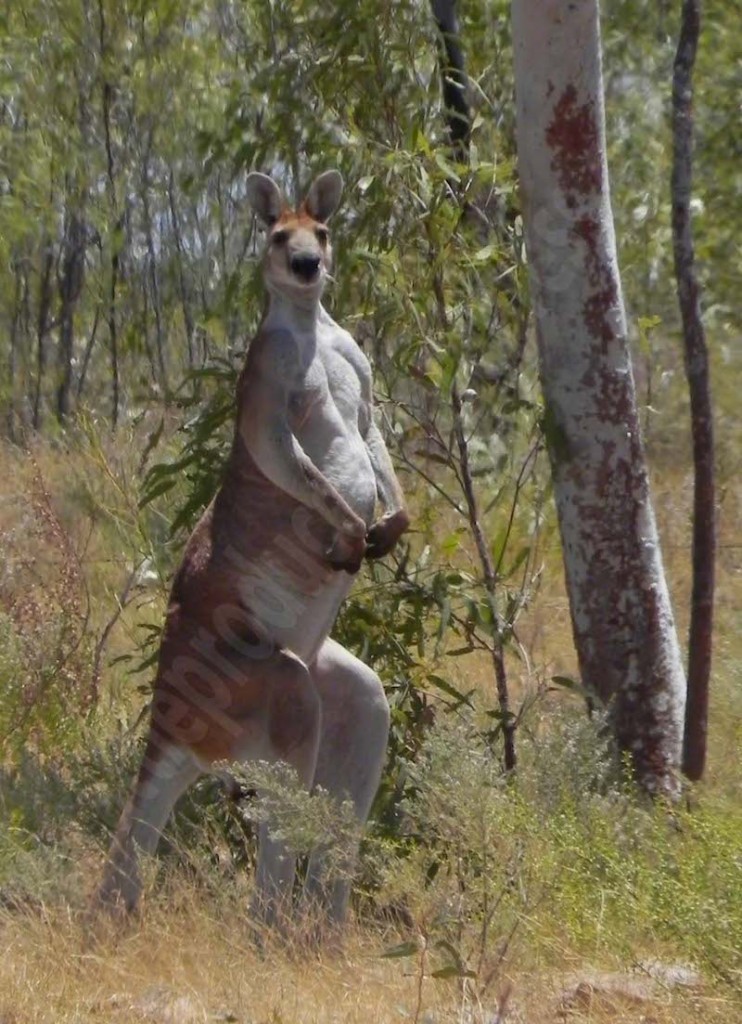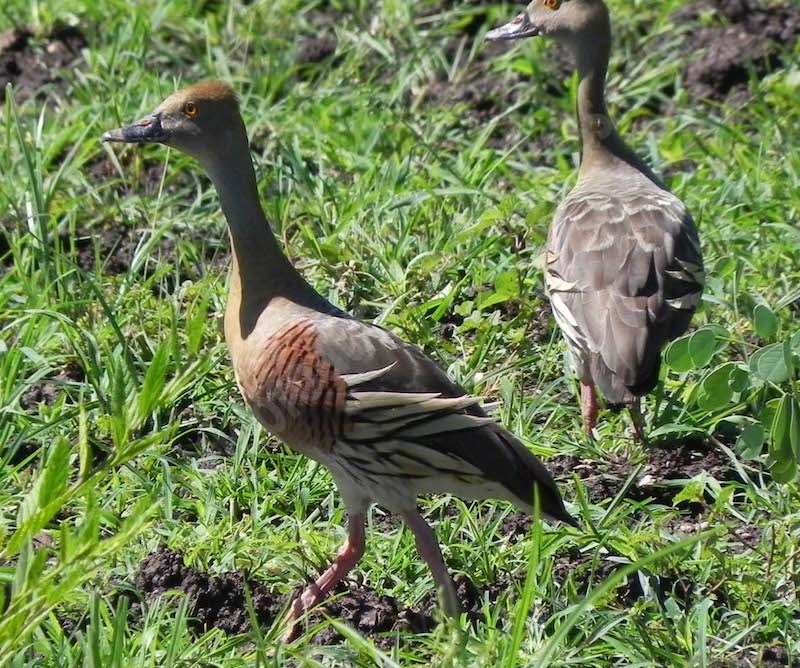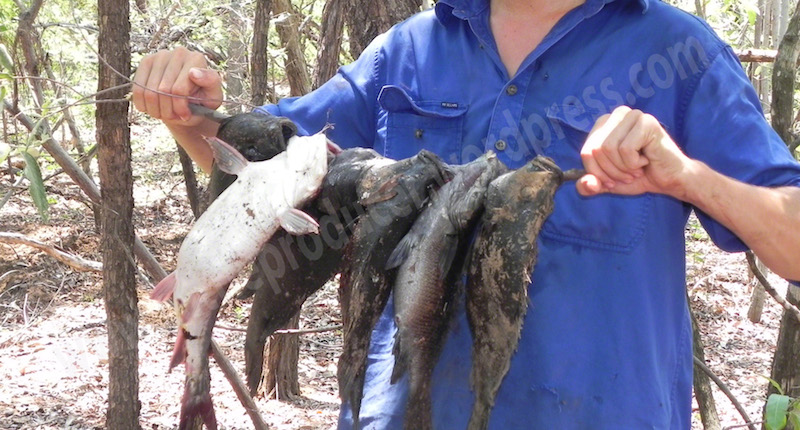Strut your stuff
Host: Hodgson River Station
Written by: Jo Bloomfield – Owner, Hodgson River Station.
The Brolgas have a red marking on their head – the older they are the darker it is. A weird gangly bird that remind me of prehistoric pterodactyls. They stand nearly 2m tall with about the same wing span. They make an odd honking calling sound while flying and apparently often return to the same place each season. Mustn’t be much good to eat as you never see the aboriginals eating them, they prefer the bush turkeys. Brolgas tend to arrive when the rain starts. Usually you see them in pairs but sometimes up to five or six at a time. Management wise they are never a problem, everyone loves to spot a Brolga. If you ever travel through Mataranka the birds there have become so used to people they are often walking along the main street which is the Stuart highway.
This big male kangaroo would stand close to 2m tall. Often we see them with half ears and assume this is from their fighting with each other. We have lots of varieties of roos and wallabies. Their red coats are effective for heat deflection. The Aboriginals often hunt on our property so kangaroo population doesn’t seem excessive, the aboriginals do tend to hunt the smaller varieties or females, probably a softer meat than these big old blokes.
We have no need to control their numbers, the biggest problem being their suicidal tendencies at night when blinded by headlights and running into cars. Often they use our water points in the dry season. About the only thing they do that affects management here is hit fences at speed and this can break the wires at times or at least twist them but isn’t really a big deal to repair. The only real argument I have with them is that they love low hanging mangos and when I was keenly watching my very first crop of mangos just about to ripen I would check them each day. To only find that the when they were nearly ready the kangaroos had got to them first and all I got was very polished large mango seeds all strewn on the ground.
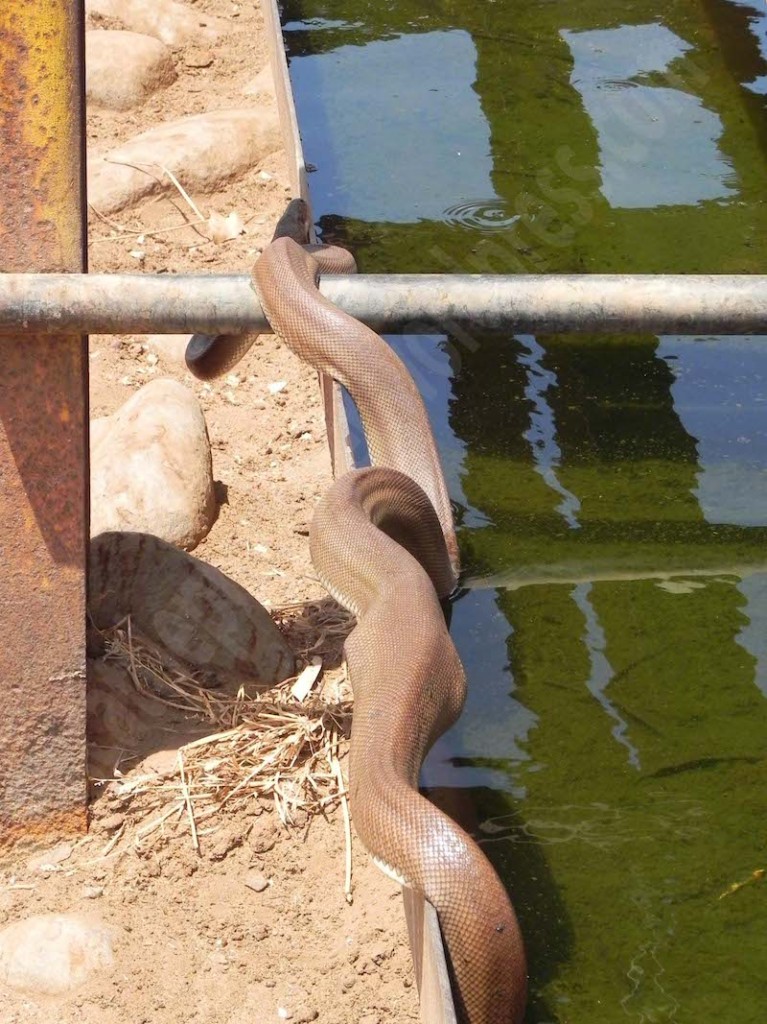
Mr Happy. He was a cranky old bugger actually, would strike at the dogs if they jumped in his trough. This old bloke is a water olive python and would be reasonably old to be this big, guessing 15-20 years. We never bothered to really measure him but he would have been over 2m. We built new tanks at this bore as pigs would wallow in the dam previously and make the water very putrid and not good for cattle to drink. Construction of tanks took away Mr Happy’s water source, so he decided to take up residence in the trough throughout the dry, probably catching small birds that also came to drink, he was always in the trough or under it and lived there for many months.
It became standard procedure that we would check each time passing to see if he was still around, our favourite of course to send unsuspecting visitors as they obliged by checking the trough to make sure it was full. Being in it wasn’t a problem unless we wanted to clean the trough out and then he’d be vacated with a broom, and go hide under the trough while we cleaned it. As long as we never hassled him he seemed unperturbed by our activities though if annoyed he could arc up and be reluctant to get out of the trough. This made cleaning ‘interesting’. Cattle never seemed to care he was in the water when they were drinking, often drinking directly above him as only his head would be out and his body completely submerged. We found him dead a few weeks after this photo, not sure if he had eaten a cane toad or was sick.
Aboriginals are absolutely terrified of pythons and will go out of their way to track and kill them. I can only think it is because with small children and with sleeping in the open these snakes would have been a serious threat. We had a frightening experience at our house when a very large python of 2.5m was disturbed by my daughter walking past and became aggressive and struck at her several times. It is the only python I have seen here who I would say was dangerous. When driving at night in the north, particularly in the wetter periods it is nothing to see four or five of these big blokes on the roads. The pythons don’t seem to have been as affected by the cane toad as some of the other snake species.
The King Browns, a very venomous, aggressive snake which was abundant in these area years ago, but since the cane toads the King Browns and many lizards and water goannas have been reported as nearly disappeared. Can’t say I’m too worried about the loss of the King Brown really they are one of the most venomous snakes in the world and at over 300km from a hospital your chance of surviving a bite from one is minimal. We also get a lot of smaller snakes, whip snakes, small children’s pythons, and tree snakes of bright striped colours.
The biggest problem with pythons is only at the house when they like to eat our chook eggs and small poultry if we have any. The biggest python we found was a massive black headed rock python that lived in a water hole and must have been close to 3m long, he was nearly 10cm in diameter. I would think the cane toads have affected and killed some of the very large old ones. We have come across some curled up and dead with no apparent injuries and have only thought old age or toads have poisoned them.
Funny little fellas these ducks, they appear in their hundreds once it starts to rain. We don’t eat any of the bird life, I think the Aboriginals do eat a few of these little guys, but to get a feed you’d need to grab a few they wouldn’t be real big once de-feathered. For all their numbers we have never found nests, a fairly shy little bird that will take off when frightened but very cute with their funny little wings plumes. They always remind me of the fancy hat fascinators women wear at the races with the elaborate way the feathers stick out.
Fish that we caught on a permanent water hole on our property. The aboriginals have caught a few really good size Barramundi at other waterholes, but we haven’t managed one of them yet. Always bit of a contest between the local aboriginal families and the fishing man in the family who can catch the biggest fish. We also have lots of turtles, bit of an aboriginal delicacy and favourite of the little kids to catch with other varieties of fresh water fish.
These crocodiles are in every single permanent water hole we have. They are generally shy and less aggressive than their cousin the saltwater croc, who we also have. This was a mature fella who came over to investigate the fishing lure being thrown in. It was taken late in the dry and can only assume the feed sources at the site were very low. This area is rarely visited therefore the animals had no fear of investigating.
We occasionally see dead ones floating in the waterholes and not sure if this is a cane toad problem or from fighting with other crocs as some of the water holes have very high croc numbers. If we sit by a waterhole for a while it is quiet easy to see them pop their heads up for breathing and when not threatened many will do this at the same time just showing their snout and eyes. In this article it mentions that freshwater crocodiles show a strong tendency to stay and return to their original waterholes. We find smaller crocs on occasion in dams and spillways where they have been washed down from floodwaters from larger holes.
We tried to eat one once and it was a very oily meat, not very nice at all. I assume the aboriginals would have eaten them, maybe in particular the eggs after laying by the females. We have a very colourful Yellow Kapok tree that apparently when in flower indicates is the time when crocodiles lay their eggs and fruiting of the tree indicates the time to collect the eggs
Articles for this week will be:
1-Wild Wild Rivers – Explanation of site and formation of river systems.
2-Roller Coaster Seasons – Variances of the wet to the dry season in North Australia (today).
3-Strut your Stuff, The Animals – Native animals of the region.
4-Get tough or die, The Plants – Native plants of the region.
5-The Weird the wacky the wonderful – Oddities and incredible feats of nature.
6-The unwanted, often despised – The feral animals and weeds.
7-Monitoring sites – How producers can pro-actively record and assess their activities.

